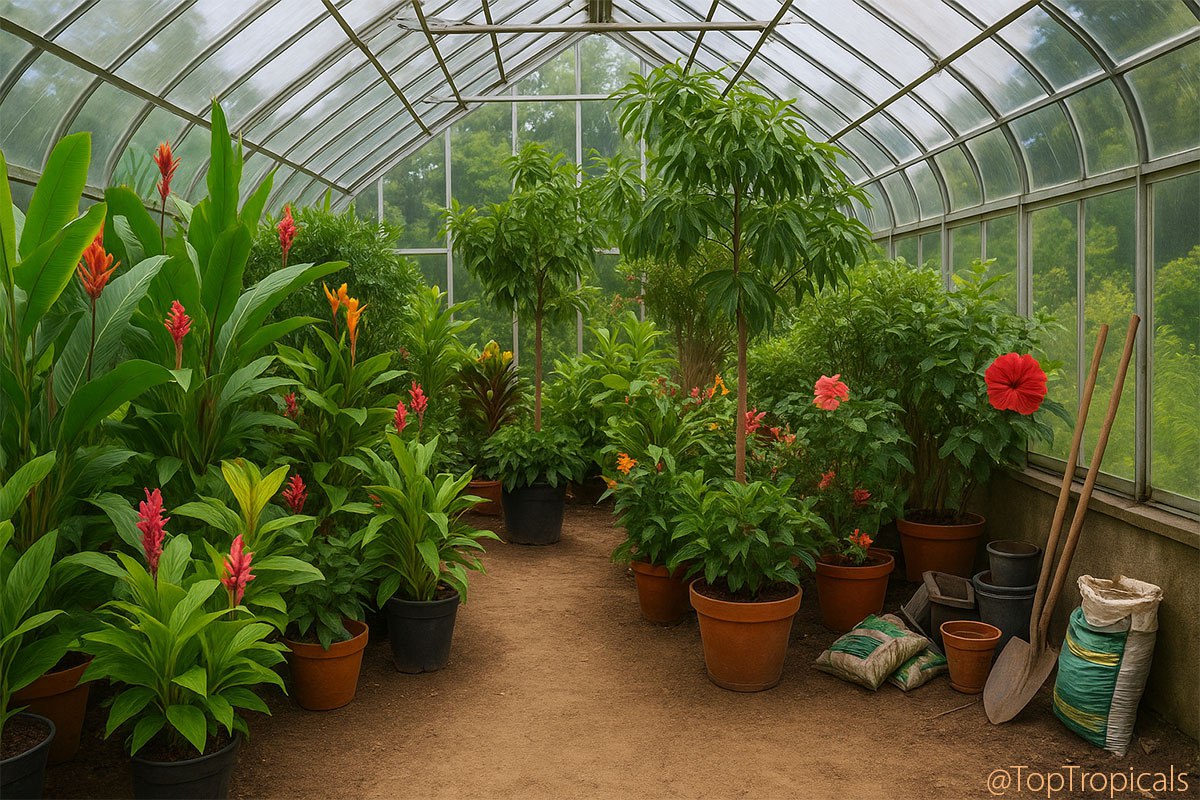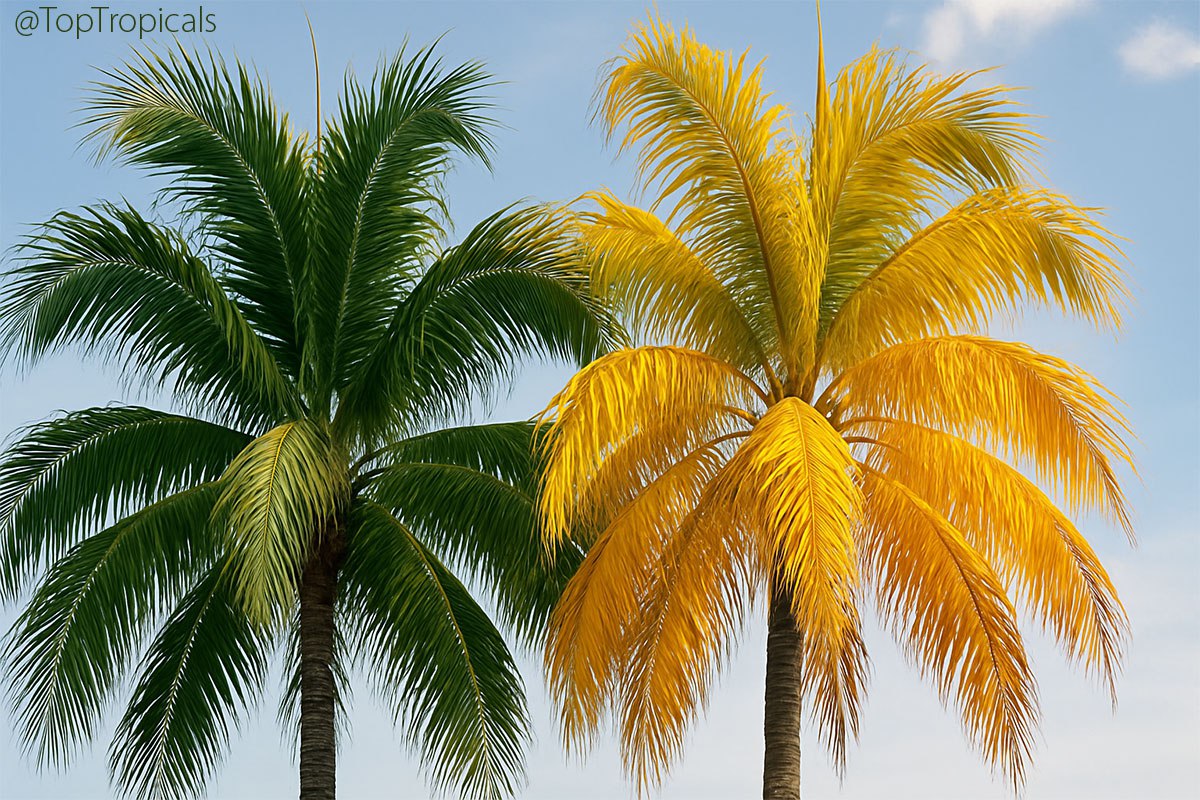Garden Blog - Top Tropicals
Ten common greenhouse mistakes and how to avoid them
🏠 Ten common greenhouse mistakes and how to avoid them
Reusing dirty pots or tools spreads disease. Clean and disinfect containers, trays, and tools regularly. Use a diluted bleach solution to clean clear plastic or ground covers if they show mold or algae buildup.
#How_to
🟢 Join 👉 TopTropicals
- 1. Overwatering
- 2. Not enough light
- 3. Too much of sun and heat
- 4. Overcrowding plants
- 5. Poor ventilation
- 6. Skipping pest inspections
- 7. No consistent schedule
- 8. Neglecting temperature and humidity control
- 9. Recycling old soil
- 10. Dirty tools, containers, and covers
It's easy to overwater in a controlled environment. Many greenhouse plants need less water than you think. Overwatering can lead to root rot, yellowing leaves, and fungal issues. Monitor soil moisture regularly and adjust watering based on the plant type, season, and current weather conditions.
Don’t block too much light - plants need full-spectrum light to thrive. Most greenhouse plants require as much light as possible to ensure healthy, vigorous growth. Lack of light causes leggy, weak plants and increases the risk of disease, pests, and fungal problems.
Greenhouses with plastic covers can trap intense heat, and during sunny afternoons, plants may get “cooked”. Direct sunlight can quickly overheat and damage foliage. Use shade cloth during the hottest months or to protect light-sensitive plants and prevent heat stress.
Packing in too many plants reduces airflow, creating ideal conditions for disease and pest outbreaks. Give each plant enough space to breathe, grow, and receive light. Proper spacing also makes pest control and maintenance easier.
Lack of airflow leads to overheating, humidity buildup, fungal disease, and weak growth. Use fans, roof vents, or roll-up sides to improve circulation and maintain healthy growing conditions.
Greenhouses can trap pests in an ideal environment. Check plants regularly for aphids, spider mites, whiteflies, and fungus. Use systemic insecticides or organic treatments like neem oil at the first sign of trouble.
Inconsistent watering, feeding, and lighting can stress your plants and reduce productivity. Set a simple routine, and monitor conditions daily - even a quick walkthrough helps catch problems early.
Temperature and humidity can fluctuate dramatically between day and night. Use a thermometer (preferably with max/min memory) and a hygrometer to track conditions. Install heaters, shade cloth, misting systems, or dehumidifiers as needed.
Modern WiFi-based sensors that monitor temperature and humidity 24/7 are convenient tools - you can keep tabs on your greenhouse right from your smartphone.
Avoid reusing soil from plants that died, as it may harbor root diseases or pests. Always use fresh, high-quality soil for new plantings. Don't cut corners - healthy soil is key to healthy plants.
Reusing dirty pots or tools spreads disease. Clean and disinfect containers, trays, and tools regularly. Use a diluted bleach solution to clean clear plastic or ground covers if they show mold or algae buildup.
#How_to
🟢 Join 👉 TopTropicals
Adenium Rainbow, Part 1
Adenium varieties
Adenium Rainbow, Part 1 🌈
Now, in June, they have more and more blooms! We are sharing these amazing colors with you.
To be continued, check back soon!⤵️
🌸 Check out the varieties still in stock and grab yours before they’re gone. Some are already sold out, but you still have a chance to score amazing blooms!
🌸 Why Collect Adeniums?
· Easy to grow indoors or out
· Over 200 hybrids at Top Tropicals
🌸 How to Grow a Big, Swollen Caudex - a simple trick with big results:
Each time you repot, raise the plant slightly to expose more of the upper roots. This encourages new root growth downward and helps form a thicker, more dramatic caudex.
📚 More about Adeniums:
🛒 Shop Adenium colors and hybrids
#Container_Garden #How_to #Shade_Garden #Adenium
🟢 Join 👉 TopTropicals
Now, in June, they have more and more blooms! We are sharing these amazing colors with you.
To be continued, check back soon!⤵️
· Easy to grow indoors or out
- · Thrive in sun, shade, and low humidity
- · Drought-tolerant, low maintenance
- · Not picky about soil
- · Stunning blooms and unique caudex shapes
- 🌸 How Many Varieties Exist?
· Over 200 hybrids at Top Tropicals
- · 100+ varieties in stock now
- · From doubles to red, purple, yellow, striped, dotted, rainbow, even black flowers - you'll want them all!
🌸 How to Grow a Big, Swollen Caudex - a simple trick with big results:
Each time you repot, raise the plant slightly to expose more of the upper roots. This encourages new root growth downward and helps form a thicker, more dramatic caudex.
- · Use a well-draining mix
- · Water only when dry - Adeniums love dry conditions
- · Feed with Sunshine Megaflor Booster that supports both caudex and blooms
- · Grow best in filtered bright light
📚 More about Adeniums:
- • More posts about #Adenium
- • The First Video of Exotic Adenium Hybrids
- • Why Adeniums are the most popular container plants
- • How to grow a happy Adenium
- • What is the easiest container plant with beautiful flowers
- • Multi-grafted Adenium with different colors of flowers on the same plant
- • What you need for successful growing Adeniums
🛒 Shop Adenium colors and hybrids
#Container_Garden #How_to #Shade_Garden #Adenium
🟢 Join 👉 TopTropicals
Why is my palm tree turning yellow?
🌴 Why is my palm tree turning yellow?
Yellowing leaves are a common concern with palms and can be a sign of several issues, most commonly: nutrient deficiency and pests or disease. Additionally, leaf yellowing may be a sign off overwatering or poor drainage, underwatering, or cold damage.
▫️Magnesium and Iron deficiency is one of the top culprits, especially in sandy soils. It causes older fronds to turn yellow with green veins.
▫️Thrips cause silvery-yellow streaks or mottling
▫️Overwatering or Poor Drainage: Too much water can suffocate roots and lead to yellowing. Make sure the soil drains well and let it dry slightly between waterings.
✔️In most cases, leaf yellowing isn't fatal, but it's a sign your palm needs attention. Focus on balanced feeding, proper watering, and pest checks to keep your palm healthy and green. Trim only fully dead fronds - yellow ones still provide nutrients to the palm. With proper care, your palm should green up again.
🛒 Shop garden supplies
#How_to #Fertilizers
🟢 Join 👉 TopTropicals
Yellowing leaves are a common concern with palms and can be a sign of several issues, most commonly: nutrient deficiency and pests or disease. Additionally, leaf yellowing may be a sign off overwatering or poor drainage, underwatering, or cold damage.
- ✔️Nutrient deficiency
- ✔️Signs of nutrient deficiencies:
Nutrient deficiency is the most frequent cause of palm issues. Palms are heavy feeders, and even a slight imbalance can lead to yellowing. Lack of nitrogen, magnesium, iron, or potassium is the leading cause.
▫️Magnesium and Iron deficiency is one of the top culprits, especially in sandy soils. It causes older fronds to turn yellow with green veins.
- ▫️Potassium deficiency causes yellow or orange spots on older fronds.
- ▫️Nitrogen deficiency leads to overall pale yellowing, especially in new growth.
- ✔️How to fix?
- ✔️Pests and Diseases
- ✔️Signs of pests:
Use a slow-release fertilizer with high Nitrogen content, like Green Magic, that includes all these elements; with 16-6-11 grade and 6 months release, it turns plants green very quickly! You can also use a balanced liquid fertilizer like Sunshine Robusta. Additionally, a supplement of magnesium sulfate (Epsom salt) and micro-element supplement containing chelated Iron can help, like Sunshine Superfood (amino-acid based natural product).
Pests and fungal diseases can lead to yellowing. Check for signs of scale, mites, or fungal and bacterial problems, especially if yellowing is uneven or spotted.
▫️Thrips cause silvery-yellow streaks or mottling
- ▫️Spider mites, especially in dry conditions, cause yellow speckling
- ▫️Scale insects can suck sap and weaken fronds
- ▫️Mealybugs often found in leaf bases and crowns
- ✔️How to fix?
- ✔️Lethal yellowing
- ✔️How to fix?
- ✔️Other causes
Inspect your palm regularly and treat pests early with neem oil, insecticidal soap, or horticultural oil.
Lethal yellowing is a serious disease caused by a phytoplasma, a type of bacteria-like organism. It affecting mostly Coconut palms and some other species like Phoenix (Date) palms. It causes premature fruit drop, yellowing of fronds starting from the lower ones, and eventual death of the tree.
Unfortunately, there's no cure, but early removal of infected trees can slow the spread. Disease-resistant coconut varieties are available.
▫️Overwatering or Poor Drainage: Too much water can suffocate roots and lead to yellowing. Make sure the soil drains well and let it dry slightly between waterings.
- ▫️Underwatering: Dry soil for too long will stress the palm. Water deeply but infrequently.
- ▫️Cold Damage: Exposure to cold temperatures can turn fronds yellow or brown, especially in tropical varieties.
✔️In most cases, leaf yellowing isn't fatal, but it's a sign your palm needs attention. Focus on balanced feeding, proper watering, and pest checks to keep your palm healthy and green. Trim only fully dead fronds - yellow ones still provide nutrients to the palm. With proper care, your palm should green up again.
🛒 Shop garden supplies
#How_to #Fertilizers
🟢 Join 👉 TopTropicals
How to grow the Amazing Peanut Butter Tree - in one short video
🍯 How to grow the Amazing Peanut Butter Tree - in one short video
📱
📚 Learn more:
🛒 Shop Peanut Butter Tree
#Food_Forest #How_to
🟢 Join 👉 TopTropicals
Peanut Butter Tree (Bunchosia argentea) earns its name from its fleshy fruits that boast a delightful peanut butter flavor. One of the most fascinating exotic fruit, as amazing as Miracle fruit, Peanut Butter Fruit is loved by both kids and adults... and yes, it tastes exactly like peanut butter!.. Yet it is much healthier food, with many medicinal benefits...
Compact in size, small tree reaching only 10-15 ft or kept as a bush, it's a perfect choice for limited spaces. Can thrive indoors, starting to fruit within just 2-3 years from seed. Watch the video how easy it is to grow:
📱
📚 Learn more:
- 💋Top 10 fast-fruiting trees: #10. Peanut Butter Tree (Bunchosia argentea)
- 💋Delectable Peanut Butter Tree
- 💋The best small fruit trees that will produce right away
- 💋How soon will Peanut Butter Tree fruit?
- 💋Top 10 fast-fruiting trees
🛒 Shop Peanut Butter Tree
#Food_Forest #How_to
🟢 Join 👉 TopTropicals
Give your plants their Green Magic treat
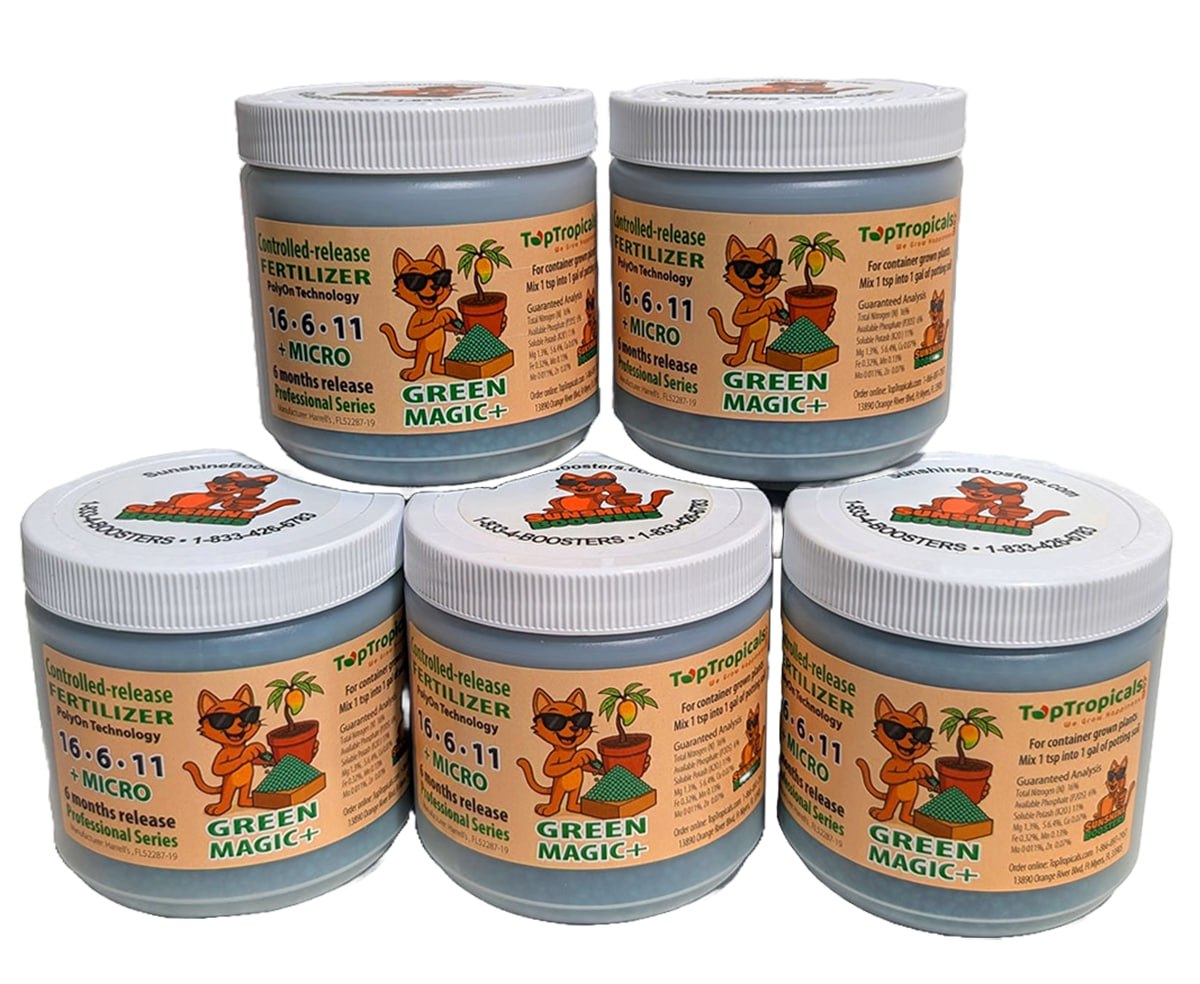
Green Magic controlled release fertilizer in jars
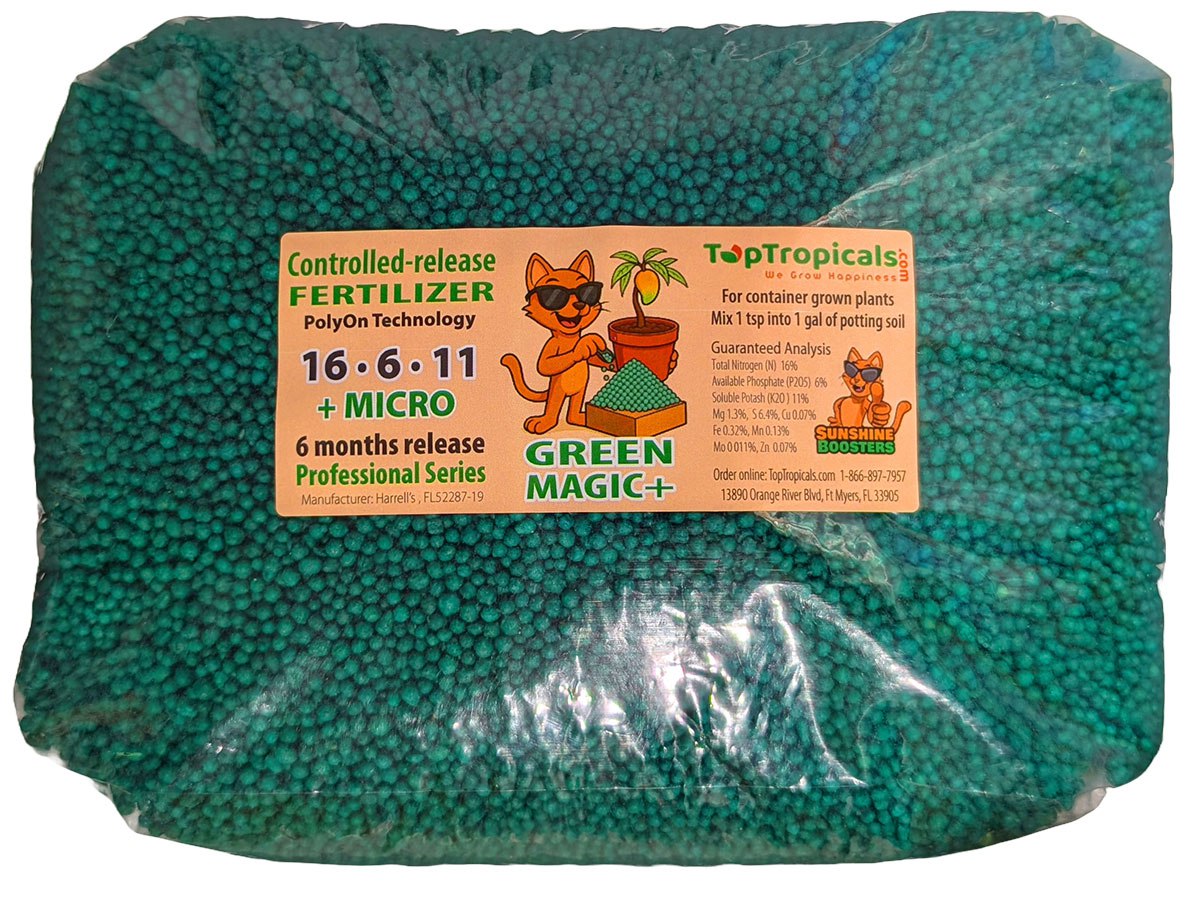
Green Magic controlled release fertilizer in a bag

Green Magic controlled release fertilizer

Green Magic controlled release fertilizer label
🍀 Give your plants their magic treat
Bring your plants back to life with Green Magiс Fertilizer (16-6-11) - professional formula for container-grown fruit trees and ornamentals.
📊 What's in it? Guaranteed analysis:
Macro-nutrients:
Total Nitrogen (N) – 16.00%
Available Phosphate (P₂O₅) – 6.00%
Soluble Potash (K₂O) – 11.00%
Micro-nutrients:
Magnesium (Mg) – 1.3% (Water Soluble Magnesium 1.3%)
Sulfur (S) – 6.4% (Combined Sulfur)
Copper (Cu) – 0.07% (Water Soluble Copper)
Iron (Fe) – 0.32% (Chelated Iron)
Manganese (Mn) – 0.13% (Water Soluble Manganese)
Molybdenum (Mo) – 0.011%
Zinc (Zn) – 0.07% (Water Soluble Zinc)
⚙️ How to use:
Apply 1 tea spoon per 1 gal of soil (mix in with soil) every 6 months during active growth period, or with every re-potting.
🛒 Watch the magic begin
#Fertilizers #How_to
🟢 Join 👉 TopTropicals
Bring your plants back to life with Green Magiс Fertilizer (16-6-11) - professional formula for container-grown fruit trees and ornamentals.
📊 What's in it? Guaranteed analysis:
Macro-nutrients:
Total Nitrogen (N) – 16.00%
Available Phosphate (P₂O₅) – 6.00%
Soluble Potash (K₂O) – 11.00%
Micro-nutrients:
Magnesium (Mg) – 1.3% (Water Soluble Magnesium 1.3%)
Sulfur (S) – 6.4% (Combined Sulfur)
Copper (Cu) – 0.07% (Water Soluble Copper)
Iron (Fe) – 0.32% (Chelated Iron)
Manganese (Mn) – 0.13% (Water Soluble Manganese)
Molybdenum (Mo) – 0.011%
Zinc (Zn) – 0.07% (Water Soluble Zinc)
⚙️ How to use:
Apply 1 tea spoon per 1 gal of soil (mix in with soil) every 6 months during active growth period, or with every re-potting.
🛒 Watch the magic begin
#Fertilizers #How_to
🟢 Join 👉 TopTropicals
How to make plants green quickly? Green Magic - the fertilizer that truly works like magic!
Green Magic controlled release fertilizer
🌳 How to make plants green quickly? Green Magic - the fertilizer that truly works like magic!
🛒 Buy once, feed for 6 months!
#Fertilizers #How_to
🟢 Join 👉 TopTropicals
- 💚 Watch your plants come back to life and thrive with this professional-grade, controlled-release fertilizer - Green Magic. Even struggling plants can turn lush and green again!
- 💚 What makes it special? Green Magic uses poly-on technology to release nutrients slowly over 6 months - no root burn, no guesswork. Just steady, balanced feeding with all the essential macro and micro-elements your plants need.
- 💚 Ideal for container-grown fruit trees and ornamentals. One dose lasts for six months!
- 💚 How to use: Just mix 1 teaspoon per 1 gallon of soil every 6 months or during re-potting. That's it!
- 💚 Give it a try - your plants will thank you!
🛒 Buy once, feed for 6 months!
#Fertilizers #How_to
🟢 Join 👉 TopTropicals
How to make bonsai with Shaving Brush Tree
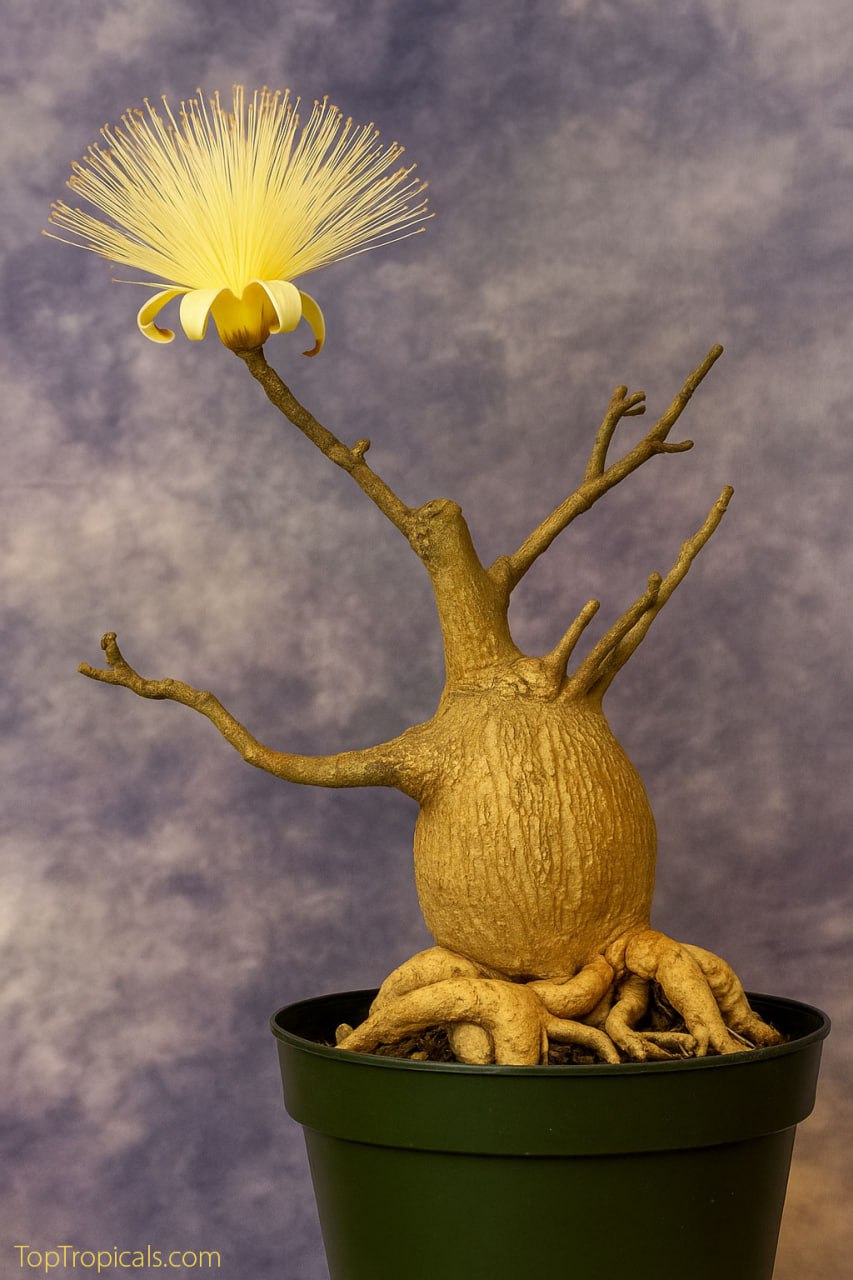
Shaving Brush Tree bonsai - Pseudobombax ellipticum

Shaving Brush Tree bonsai - Pseudobombax ellipticum

Shaving Brush Tree bonsai - Pseudobombax ellipticum
How to make bonsai with Shaving Brush Tree
Creating a bonsai from a Shaving Brush Tree Pseudobombax ellipticum is a fun and rewarding project. This unusual plant, with its fat trunk and wild, pom-pom-like flowers, makes one of the most eye-catching bonsai you can grow. It's not your typical bonsai tree - it's a conversation piece that looks like something from a fantasy world! With a little patience, it becomes a living sculpture that blooms with flair.
🛒 Start your own Shaving Brush Bonsai
📚 Learn more:
Why is it called Shaving Brush?
#How_to #Container_Garden #Trees
🟢 Join 👉 TopTropicals
Creating a bonsai from a Shaving Brush Tree Pseudobombax ellipticum is a fun and rewarding project. This unusual plant, with its fat trunk and wild, pom-pom-like flowers, makes one of the most eye-catching bonsai you can grow. It's not your typical bonsai tree - it's a conversation piece that looks like something from a fantasy world! With a little patience, it becomes a living sculpture that blooms with flair.
- Start with young plant with a fat trunk (caudex) and interesting shape.
- Use shallow pot with fast-draining cactus mix.
- Prune branches to create structure and shape.
- Trim roots gently when repotting every 2-3 years.
- Water well during growing season, keep almost dry in winter.
- Give full sun to keep compact and encourage blooms.
- Fertilize lightly: with slow release plant food in spring-summer or year around with liquid fertilizer like Sunshine Boosters.
- Be patient - bonsai is a slow grower but worth it for the amazing flowers.
🛒 Start your own Shaving Brush Bonsai
📚 Learn more:
Why is it called Shaving Brush?
#How_to #Container_Garden #Trees
🟢 Join 👉 TopTropicals
How to grow Dragon Fruit
🐉 How to grow Dragon Fruit
📱
📚 Learn more:
🛒Grow your own Tasty Dragon Fruits
#Food_Forest #How_to #Dragon_Fruit
🟢 Join 👉 TopTropicals
🌵 Selenicereus megalanthus - Yellow Pitaya, Dragon Fruit Palora, is the best tasting Dragon Fruit in the world that is not only sweet, it has a great flavor (unlike most pitayas that are pretty watery).
🌵This particular species of Dragon fruit doesn't mind regular water and rains but is also drought-tolerant. Watch a short video how to grow it:
📱
📚 Learn more:
- · Planting your own Dragon Fruit plantation
- · Do-It-Yourself Support Structure for Dragon Fruit
- · Grow Your Own Exotic Dragon Fruit Garden
- · Top 10 fruit you'll ever need for your health benefits: Dragon fruit
- · What does Dragon Fruit Flower look like?
- · Why you need to grow your own dragon fruit
- · Do red, white and yellow Dragon fruit taste differently?
- · What to do with a lot of Dragon Fruit
🛒Grow your own Tasty Dragon Fruits
#Food_Forest #How_to #Dragon_Fruit
🟢 Join 👉 TopTropicals
Mandevilla or Dipladenia?
Mandevilla and Dipladenia
❤️ Mandevilla or Dipladenia?
❓Q: What is the correct name – Mandevilla or Dipladenia? I see both names in garden centers, and they come in many colors. What color is Dipladenia and what is Mandevilla?
‼️ A: Both names are correct, and you’ll often see them used interchangeably - but they aren’t exactly the same. Mandevilla and Dipladenia are closely related, and with so many hybrids, the lines between them can blur.
🌺 Difference Between Mandevilla and Dipladenia
📚 Learn more:
🛒 Explore Mandevilla-Dipladenia colors: collect them all!
#How_to #Container_Garden #Hedges_with_benefits
🟢 Join 👉 TopTropicals
❓Q: What is the correct name – Mandevilla or Dipladenia? I see both names in garden centers, and they come in many colors. What color is Dipladenia and what is Mandevilla?
‼️ A: Both names are correct, and you’ll often see them used interchangeably - but they aren’t exactly the same. Mandevilla and Dipladenia are closely related, and with so many hybrids, the lines between them can blur.
🌺 Difference Between Mandevilla and Dipladenia
- 💋Mandevilla is a vigorous woody vine with large, stiff leaves. It’s ideal for vertical spaces like trellises and fences.
- 💋Dipladenia is a bushier, more compact plant with smaller, smoother leaves. While it can be trained on a trellis, it’s better suited for hanging baskets, pots, or as a specimen plant.
- 💋Both Mandevilla and Dipladenia come in a variety of colors - white, pink, red, and even yellow so color is not what distinguishes them. It's the growth habit and leaf type that set them apart.
📚 Learn more:
🛒 Explore Mandevilla-Dipladenia colors: collect them all!
#How_to #Container_Garden #Hedges_with_benefits
🟢 Join 👉 TopTropicals
Watch the biggest Vanilla Orchid in the world moving to 100 gal pot!
🏆 Watch the biggest Vanilla Orchid in the world moving to 100 gal pot!
Vanilla dillioniana - The Biggest Vanilla Orchid grown in 100 Gal Pot! "Intelligent Design" by Robert Riefer.
Today we take a tour in Robert's garden, where he shows us the secret of growing the biggest vanilla orchid in the world. To find out how, watch this video filmed in 2017, and check out updates of this monster plant in the next post!
📱
🛒 Get your own super rare Leafless Vanilla dilloniana - propagated from this exact historical plant!
#Container_Garden #Shade_Garden #Nature_Wonders #How_to
🔴 Join 👉 TopTropicals
Vanilla dillioniana - The Biggest Vanilla Orchid grown in 100 Gal Pot! "Intelligent Design" by Robert Riefer.
Today we take a tour in Robert's garden, where he shows us the secret of growing the biggest vanilla orchid in the world. To find out how, watch this video filmed in 2017, and check out updates of this monster plant in the next post!
📱
🛒 Get your own super rare Leafless Vanilla dilloniana - propagated from this exact historical plant!
#Container_Garden #Shade_Garden #Nature_Wonders #How_to
🔴 Join 👉 TopTropicals
